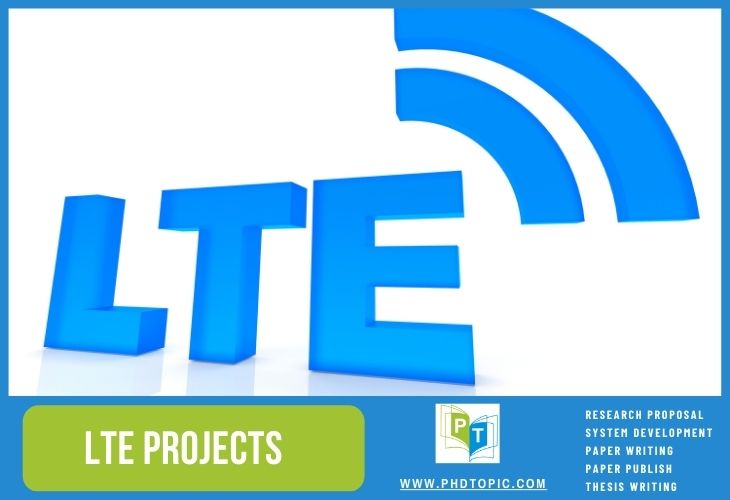LTE-based communication is aimed to fulfill the needs of a packet-oriented system for low-level network access. Also, it majorly concerns enhancing the system coverage and capacity. Further, in comparison with other communication systems, LTE Projects offers the high performance of the network utilizing certain parameters. And the most significant network parameters are scalability, bandwidth, greater data transfer rate, seamless other network integration and delay of low-level network access, etc.
From this article, the final year students can learn more interesting information about LTE projects with their emerging technologies!!!
As a matter of fact, our resource team has the motive to deliver the original facts about LTE projects which we gained from our long-lasting experience on academic final projects. Most importantly, we take end-to-end responsibility in student’s projects to let them free from stress in project development. Though we assist you to develop your project execution, we also make you understand the various stages of project development like,
- Theoretical Analysis
- Project Needs Collections
- System Architecture Design
- Segmentation of Module
- Development of Modules
- Project Report Preparation

What is an LTE-A network?
Now, we can see about the Long Term Evolution-Advanced (LTE-A) network which is the extended version of LTE for cellular communication. Comparatively, LTE-A is faster in data transmission than the standard LTE network. Also, it supports 4G communication protocols.
Then, the common aspects of LTEA-A and LTE systems are abilities to support femto / pico base stations, internetworking on heterogeneous networks, flat IP connections, relay nodes, etc. Though these two technologies are enriched in advanced characteristics, and they have few technical issues related to the security aspect of the system architectures.
LTE Architecture
Generally, the architecture of the LTE network is made up of two constitutes where one is Evolved Packet Core (EPC) and the other is E-UTRAN. Here, EPC was replaced with the classic circuit-switched network by a fully packet-switched network along with IP for voice service of LTE communication systems.
And, EPC is comprised of a combo of MME, SGW, and PDN GW for Home Subscriber Server (HSS). In this, if the UE make a contact with EPC, then the EPC executes the mutual authentication among UE. Similarly, E-UTRAN is comprised of eNodeBs to establish the interaction with UEs where E-UTRAN stands for Evolved Universal Terrestrial Radio Access Network Base Stations.
Based on the recent research of the LTE network, our research team has identified many research areas by focusing on the research interest of students. For your reference, we have listed only a few of them. Once, you get tie-up with us, we let you know more technical growth in your selected research areas. Here, we have given you few widely used techniques in top-research areas of LTE networks. Since techniques are more important to solve your handpicked research problems.
Latest Techniques on LTE
- Energy-Aware Approaches
- Energy Harvesting and Saving Techniques
- Large-Scale Data Access Control Approaches
- Collision Resolution and Traffic Control
- Performance Enhancement Approaches
- Increases in RACH throughput
- Decreases of Access Delay
Our experts are unique in tackling problems because of their smart creative thinking. In the case of complex problems, our experts passionately create their own techniques (like algorithms, protocols, etc.) or integrate different techniques to form unified solutions for breaking the problems in LTE Projects. To achieve more, we have collected more trending technologies of LTE communication. Here, we have given you some technologies that can be combining with LTE networks which direct you towards next-generation LTE technologies.
Integrated Technologies using LTE
- M2M and D2D Communication
- Mobile Ad hoc and Vehicular Networking
- Cell-Free and CR Service Architectures
- Dynamic Network Slicing and Virtualization
- Service-Based Architecture (SBA) in SDN-NFV
- 5G based Huge Scale Mobile Data Transmission
- Advanced THz and Visible Light Communications
- Energy-Aware Resource-Constrained IoT Devices
- Technological Improvements in Self-Organizing Networks
- Enhancement of mmWave supported Massive MIMO Techniques
- New Developments in Mobile-Edge based LTE Applications
- Uplink/Downlink based inter-eNB with cooperative MIMO
- Integrated Sc-FDMA and OFDMA Technology for Uplink Resource
How to select a good final year project topic?
The final year project is the opportunity for students to practically implement their so far learned skills which ultimately improve their academic profile. Also, it explicitly showcases the student’s ability to build and analyze projects on their own. And, it acts as the gate pass to the students to get the higher studies entry in their interested field. Therefore, one should be always more conscious in selecting the topic for the final year project. For your awareness, here our experts have given some tips that are sure to guide you in the right direction of project developments.
- Do a survey on previous studies
- In fact, numerous people are nowadays doing their research and development. So, refer to the previously conducted research works to gain a better understanding of recent research areas which globally recognized
- Then perform an in-depth literature review on handpicked journal papers to analyze how the related research problems are solved and which techniques are mostly employed to solve the problem.
- Get the idea about a problem which are not addressed properly by inspecting the advantage and disadvantages of the previous researches
- Emphasis on any social problem
- When doing a final year project, it is essential to create a positive impact by solving any real-time issue
- Since the objective of the final year project is giving the own contribution to social developments.
- Additionally, it provides a good impression about you on an interviewer of higher studies or core jobs.
- Investigate about latest trends
- Prior to select the project topic, perform a comprehensive study on research technological advancement of the interested area
- Since it is important to know the future scope of the technologies incorporated in the project for further study.
- If the handpicked technologies are old-fashioned, then there is no use in conducting experiments. So, think multiple times before finalizing the technologies
- Acquire expert’s guidance
- Analyze the abilities of technologies that are going to be used in your project development
- Get the advice of experts from your interested field before confirming the research problems and their solutions for efficiency
To make you more familiar with the latest research direction of LTE Projects, our research team has shared some interesting research ideas for LTE projects. These ideas present to you the current demand of LTE domain students. Beyond these ideas, we provide you more choices of research ideas in your desired areas. So, take a fast move towards us before someone selecting your pearl of the topic.
Innovative Project Ideas on LTE
- Advanced-Data Protection and Confidentiality in LTE
- FDD based Asymmetric Bandwidth Allocation
- Resource and Service Handover techniques in LTE
- Machine-to-Machine Communication in Cellular Networks
- Improved Forward Error Correction and Precoding
- Dynamic Network Interference Control
- Power-Aware Resource Distribution Mechanism in LTE
Security and Privacy in LTE
Usually, the LTE/LTE-A network is created and handled by mobile operators from different parts of the world to provide cellular services for customers with first-rate performance. As mentioned earlier, the enhanced characteristics such as internetworking on heterogeneous networks and flat IP connections may increase the threat of security attacks in both LTE-A and LTE networks. For your information, here we have given you some common attacks that occur in LTE-A and LTE networks.
How secure is LTE data?
- Core Network
- Insider Attacks
- Denial of Service / Distributed DoS Attack (SGW and HSS overhead)
- User Equipment
- Mobile Malware and Botnet
- Access Network
- IP Spoofing
- Locality Tracing
- IMSI Discovery
- RF Jamming and Sniffing
- De-synchronization and Rogue Base Station Attack
- Add-on Attacks (Eavesdropping and Replay Attack)
- DDoS and DoS Attacks (Signalling DoS and Botnet established DDoS)
- IMS Network
- SQL Injection Attack
- VoLTE based Irregular Charging
- TCP / SYN Flooding Attack
- SIP-oriented Attacks
- SMS Attacks – Attacks of Powered Services, Spoofing and Spamming
- VoLTE Attacks – Spoofing, Spamming, Phishing, SIP flooding DoS and Silent Call Attacks
In order to increase the security of the network, the information transmitted over the network is encrypted and the users connected in the network are authenticated by identity. These two processes are very common in all varieties of networks like 4G, 4G LTE Projects, 5G, and beyond 5G. Further to improve the security, we can take effective preventive measures against malicious activities of attackers. For that, we have listed few precaution solutions that mitigate the attacks in the LTE network.
How to mitigate attacks in LTE networks?
- Authenticate every network component, user, and information
- Offer the encrypted internet layer for IP protocol stack
- IPSec is largely employed in commercial base stations
- Encode the communication information on using Internet Protocol Security (IPSec)
- Strengthen the verification process in the network by using public key infrastructure (PKI) certificates
Furthermore, we have also given you some criteria that are used to assess the performance and efficiency of the security models of LTE Projects. When you enhance the following parameters in the developing security models, it will give you the expected protection shield over the LTE network. Also, we assist you to incorporate more criteria in designing a security model based on the project needs to enhance the system performance.
Evaluation Criteria for Security Model
- Processing Complexity
- Represent the complication of implementing algorithms. It refers to the inherent difficulty of the algorithms.
- When the algorithm is lacking in performance then it needs resources by means of storage and processing time
- Time Latency
- Latency in detecting the attack may lead to fast spreading of attacks in the network and end up with system / network failure
- Adaptability
- If theattacks are detected by the security and control systems, then the system should automatically fine-tune the issue without human intervention.
- Strength / Robustness
- Defines the fault tolerance of the system at the time of network failure or attack.
- The system needs to accurately detect the attack based on certain influential factors such as pattern variation, threat threshold identification, etc.

About LTE Simulation Models
In general, the LTE model is designed to replicate the real network performance through end-to-end network virtualization. Whereas, this model includes a central network as EPC and air-interface based protocol stacks as E-UTRA. Further, it is expected to meet the essential requirements of the LTE community which are given below,
- Network Modelling
- Simulation Parameters and Protocol Stack Settings
- LTE device integration with UMTS, WiMax, and WiFi networks
- Network Capacity and QoS Enhancement Planning
To enable the enhanced LTE-assisted communication, the LTE model can merge into NDT, EXata, and QualNet models. In addition, it includes several component libraries to improve the network standards and operations. The most important thing in the LTE model library is to support 3GPP (release 9) based high fidelity LTE simulation in mobile networks. For instance: the following modules are used in the time of distributing the network packets for establishing LTE communication.
Some of the modules for packet transmission in LTE
- Node Mobility Module
- Packet Scheduler Module
- Traffic Generator Module
- Radio Propagation Module
- Mapping Module (from SNR to Data-rate)
Overall, we assure you that we give you the perfect research and development service for your final year project in the field of LTE networks. In that, we provide complete support starting from topic selection to project documentation. So, use this chance to avail best LTE projects by contacting our team.
